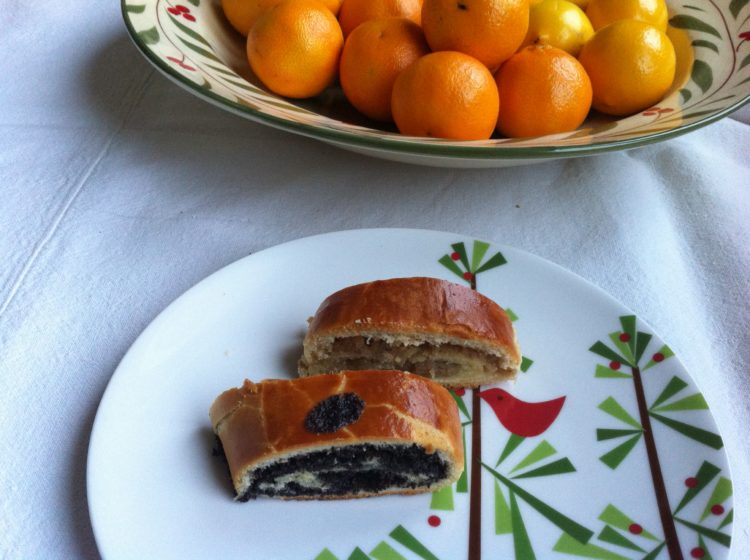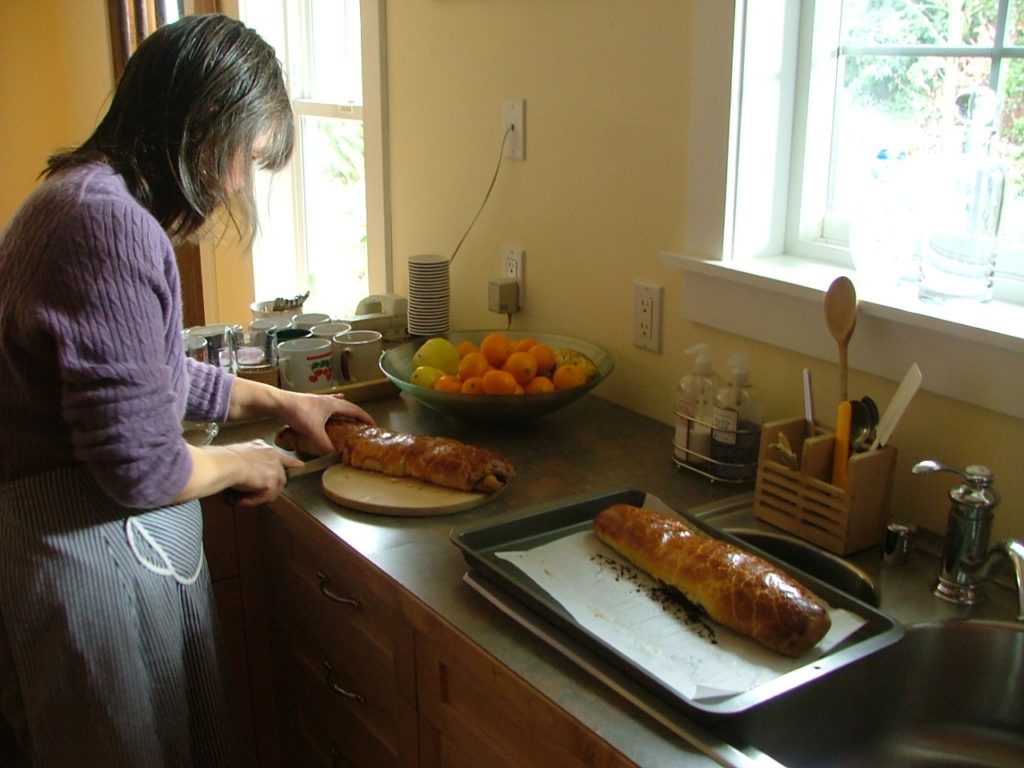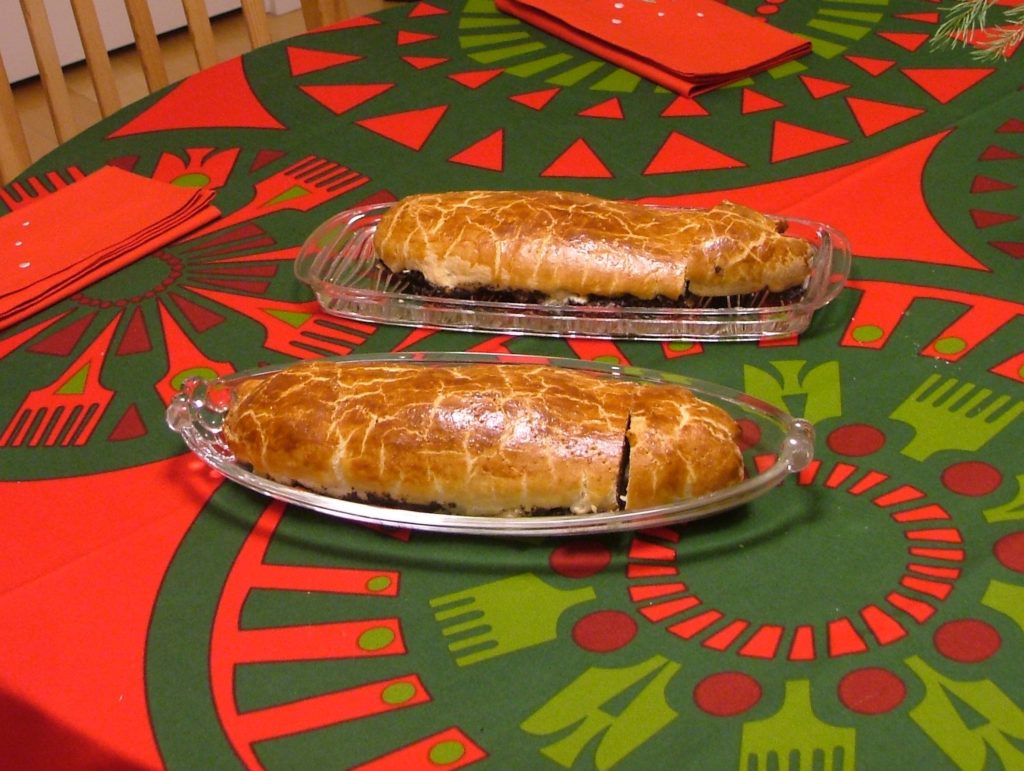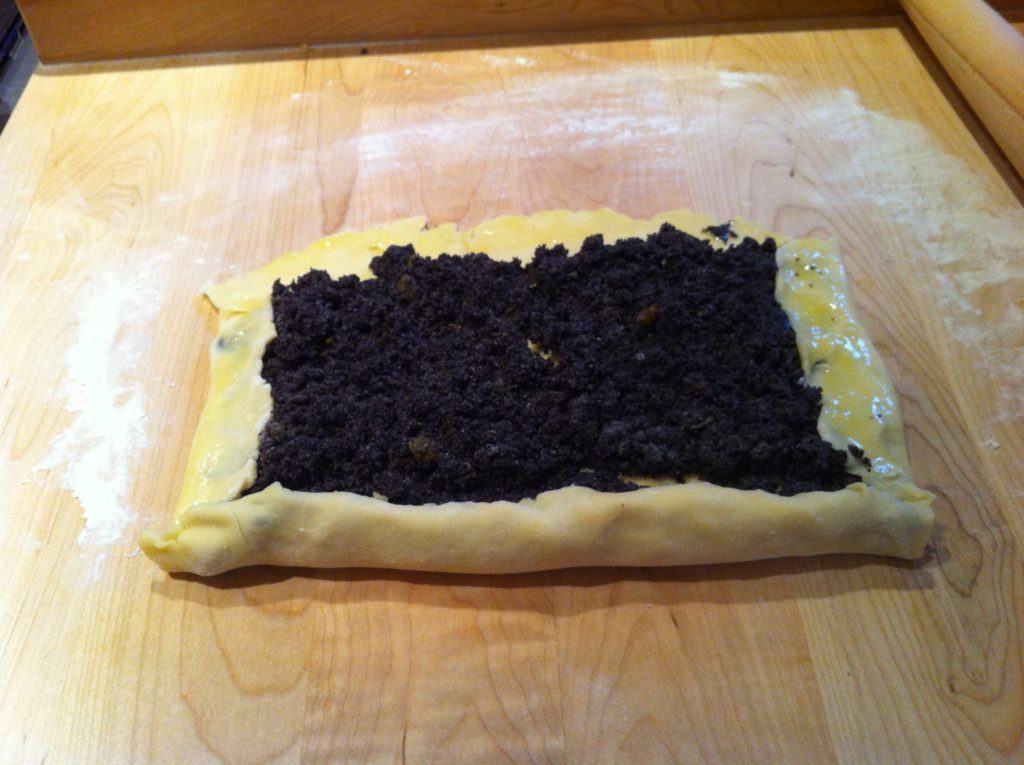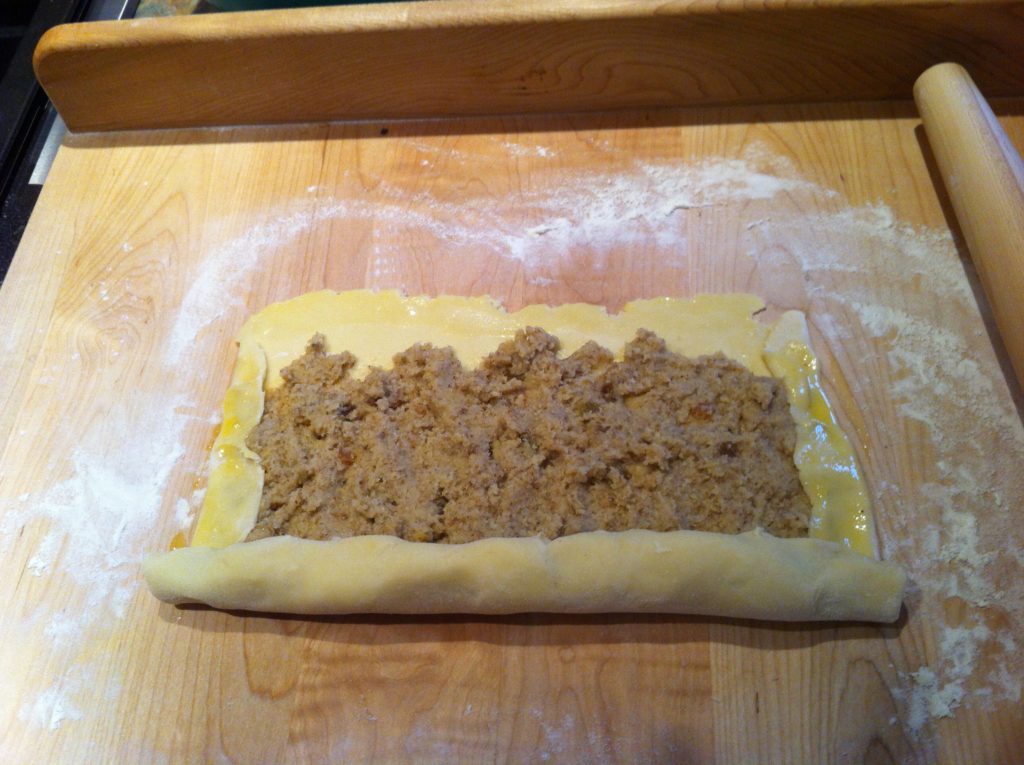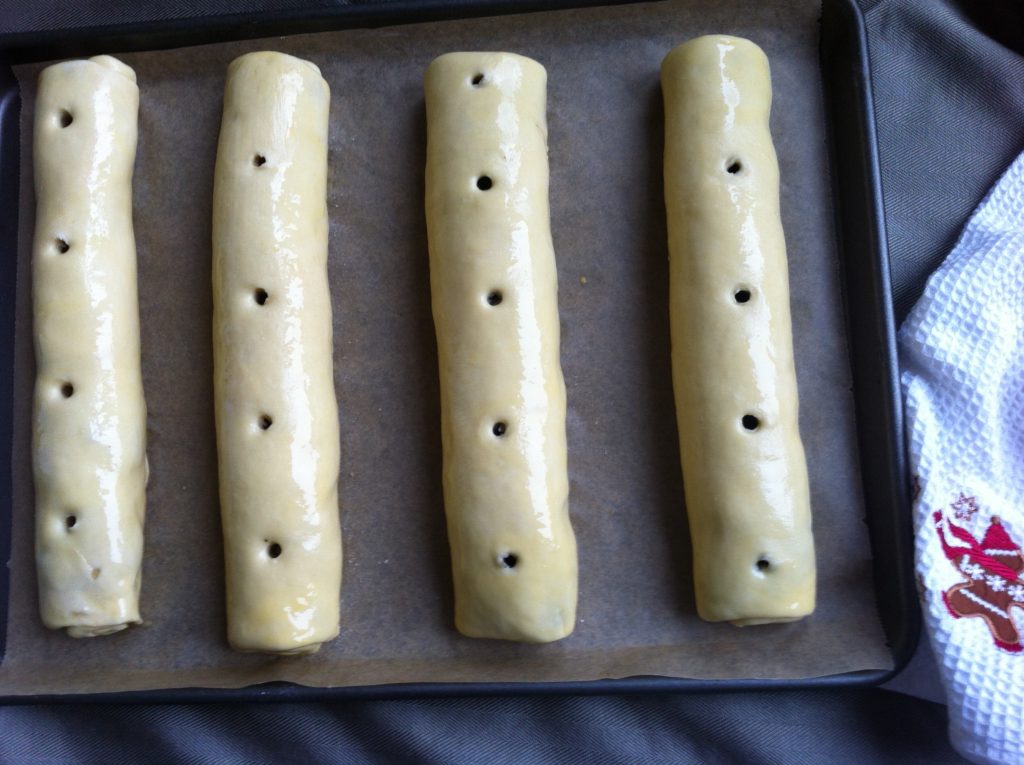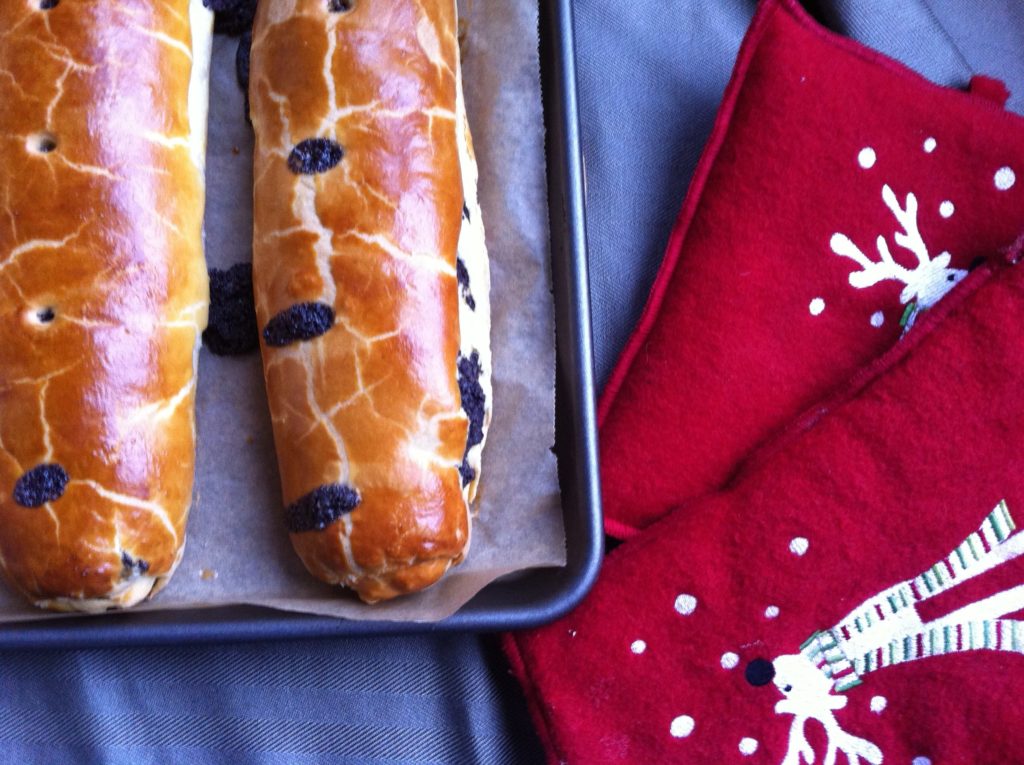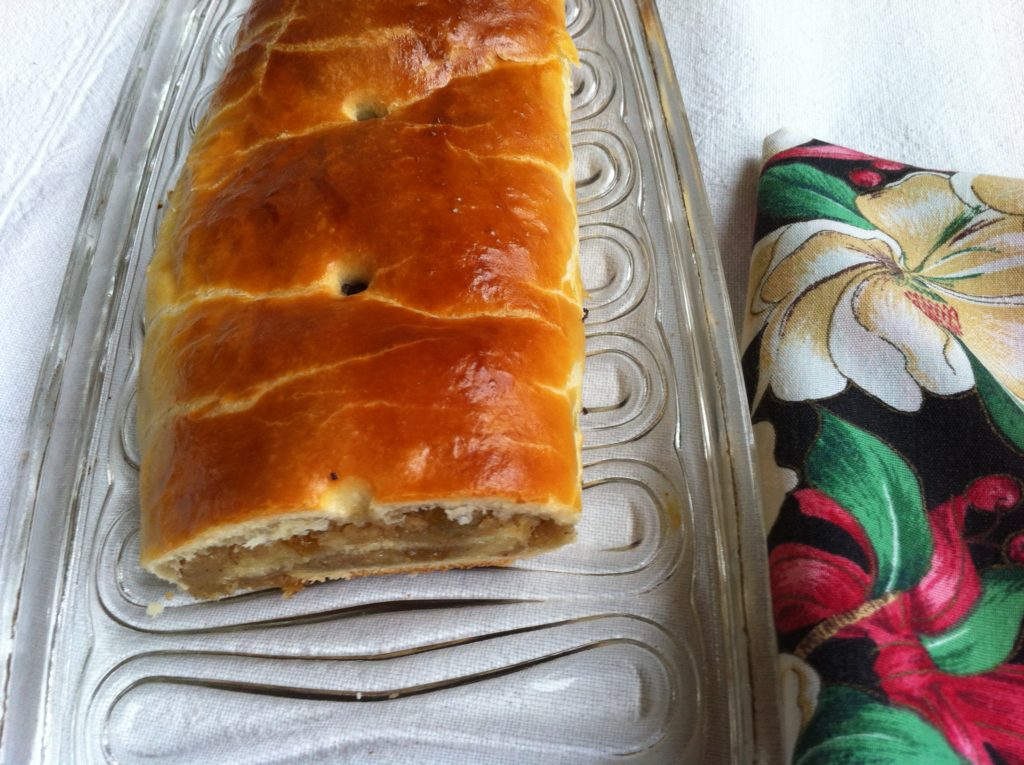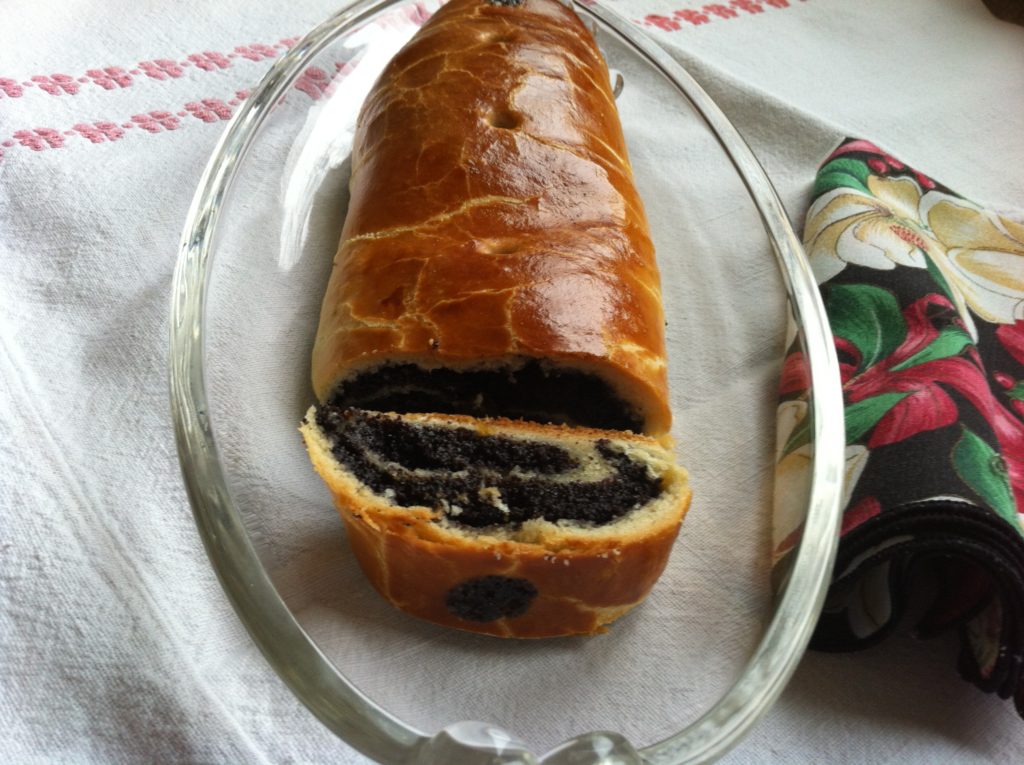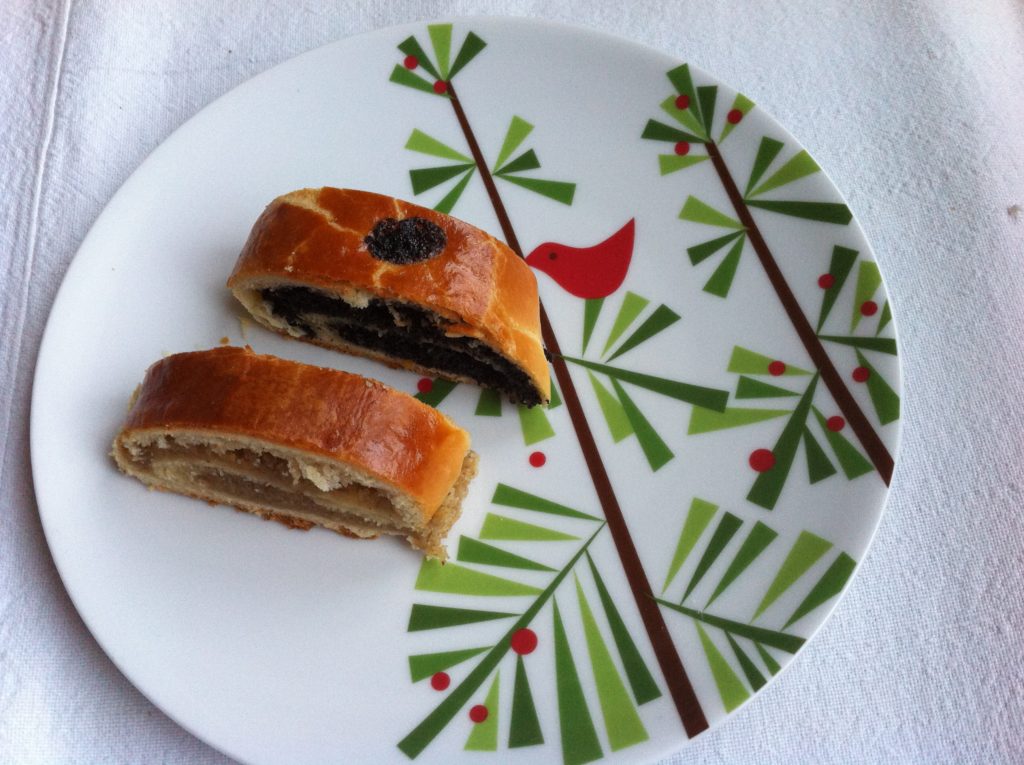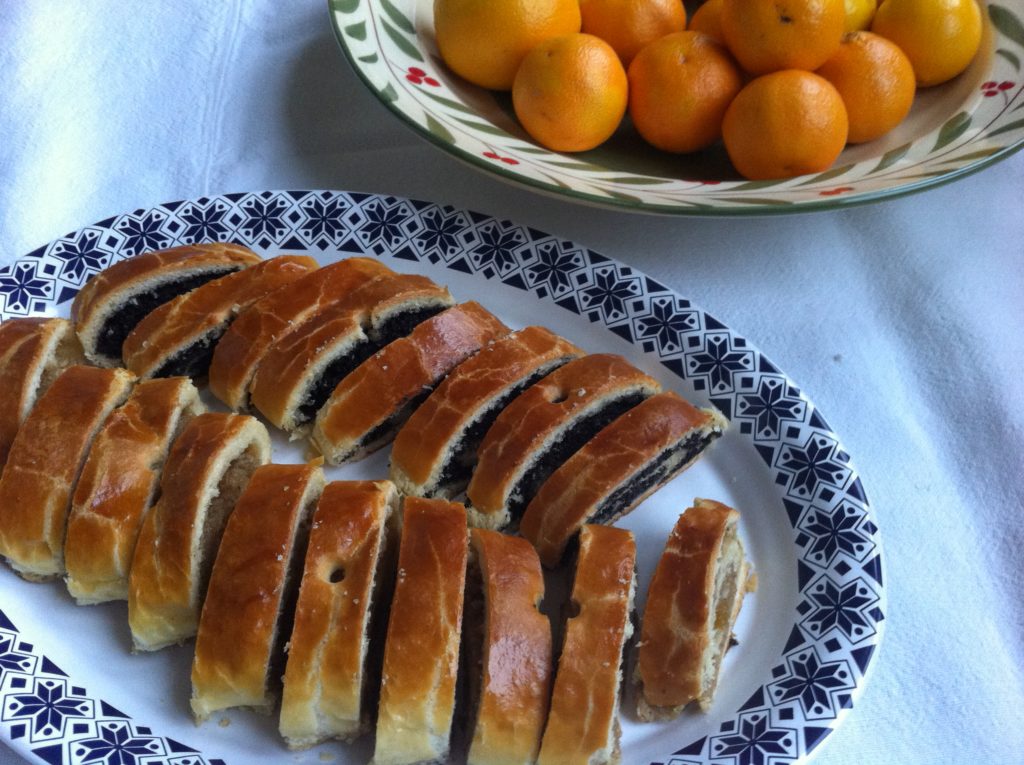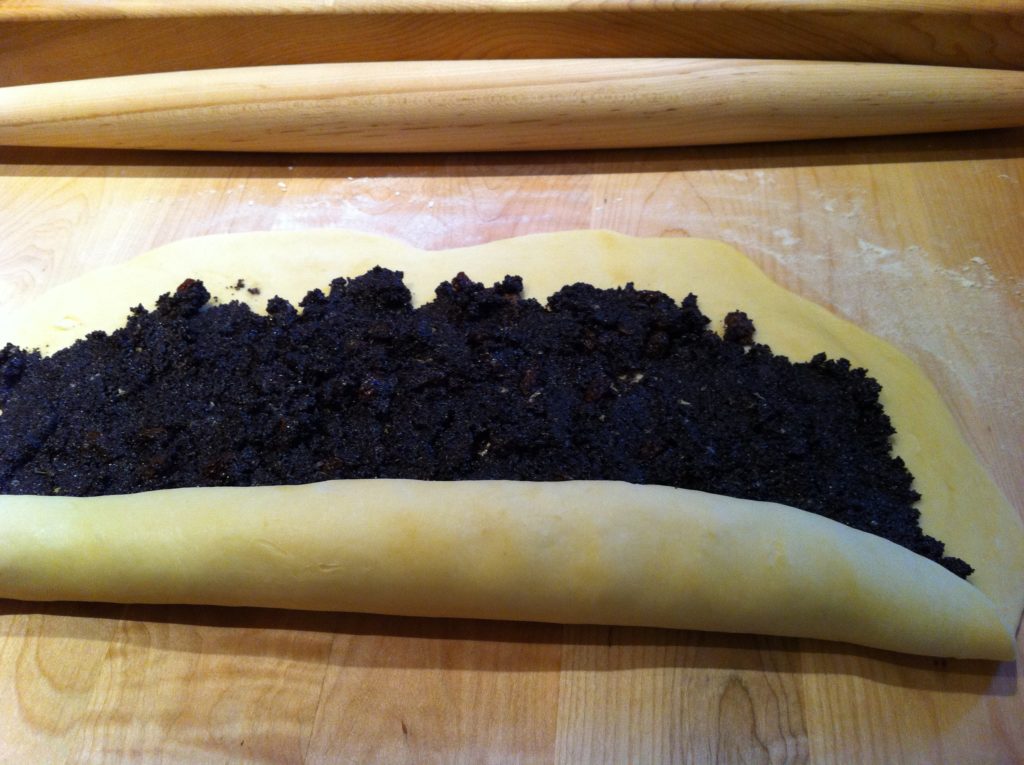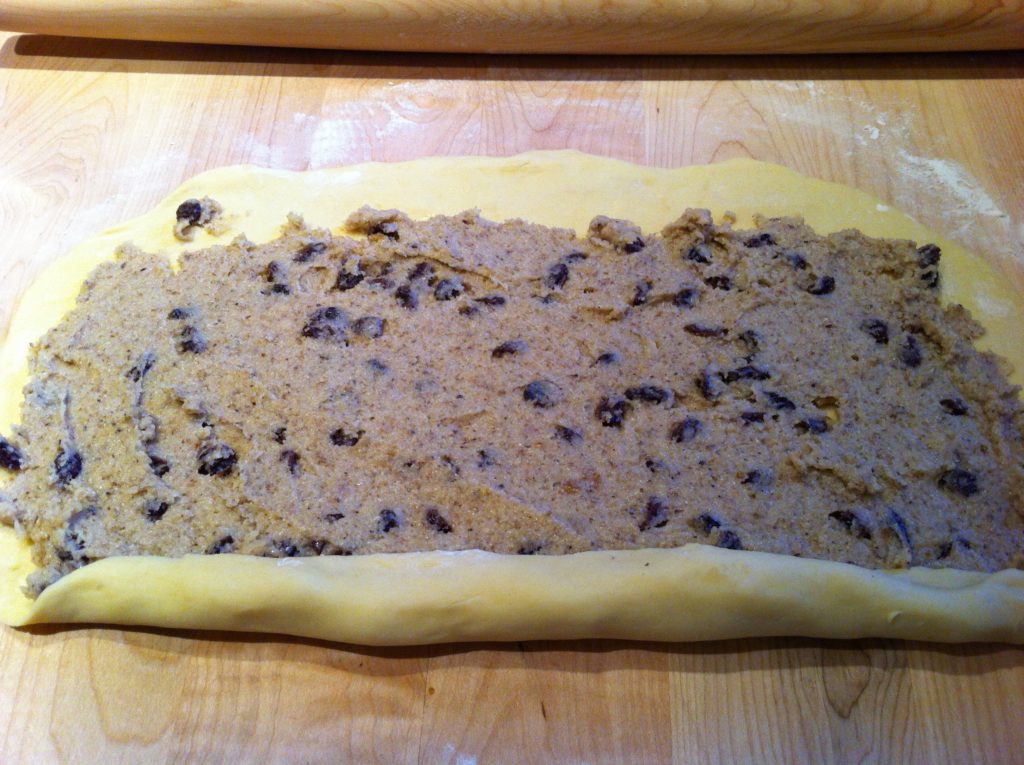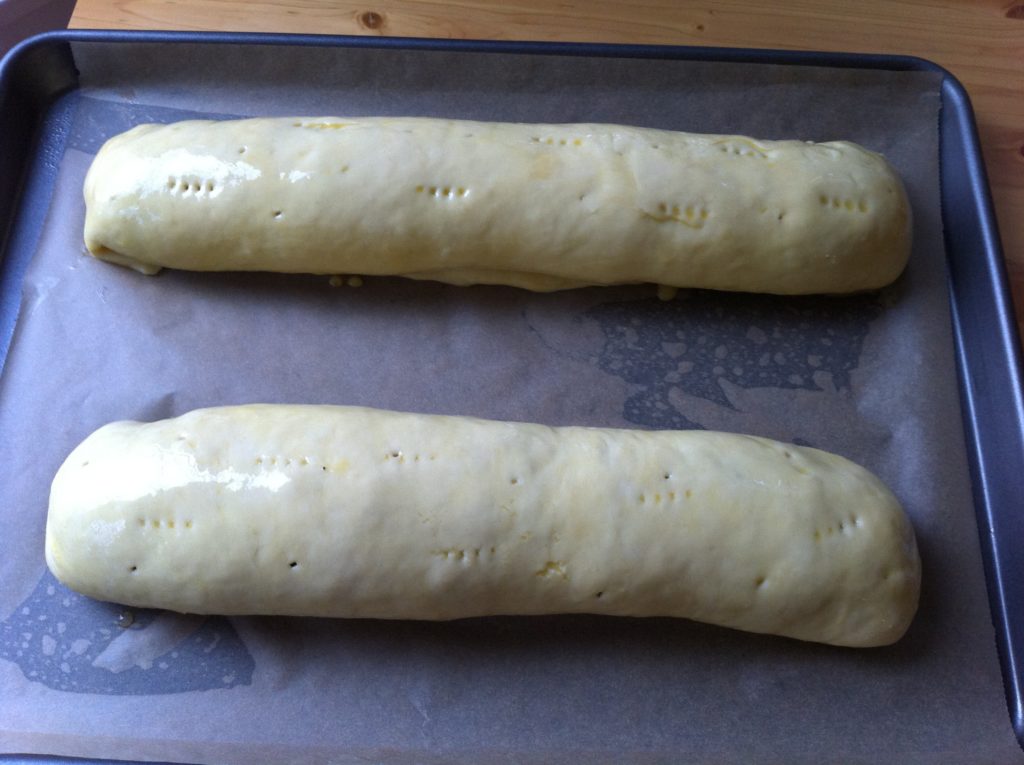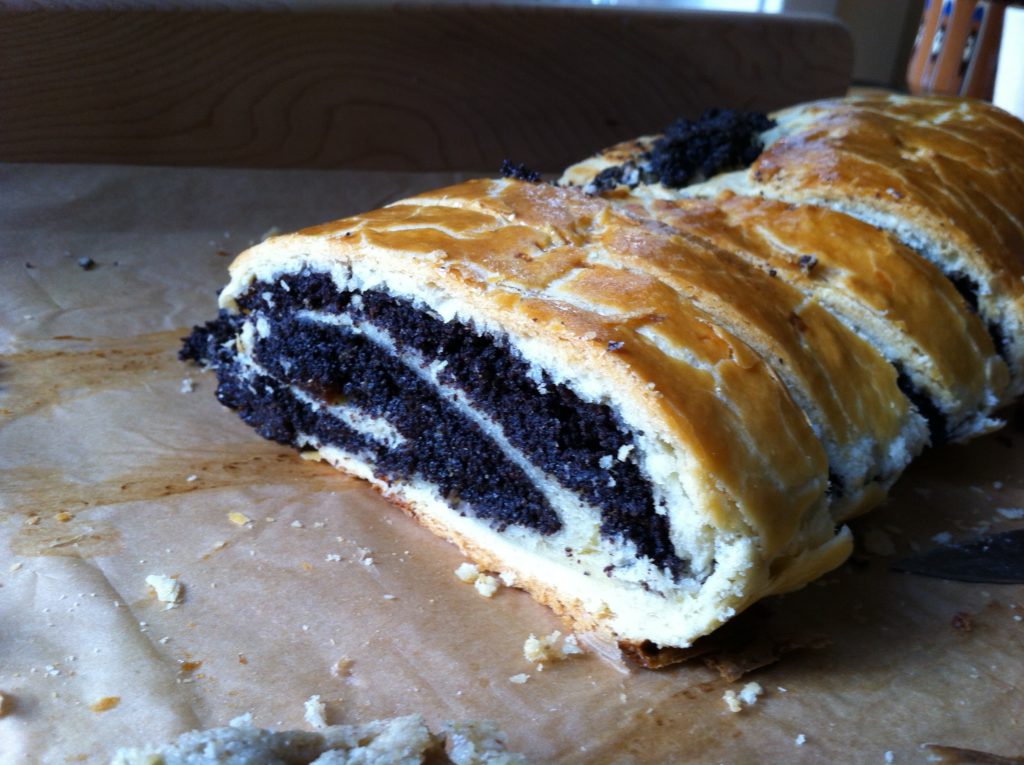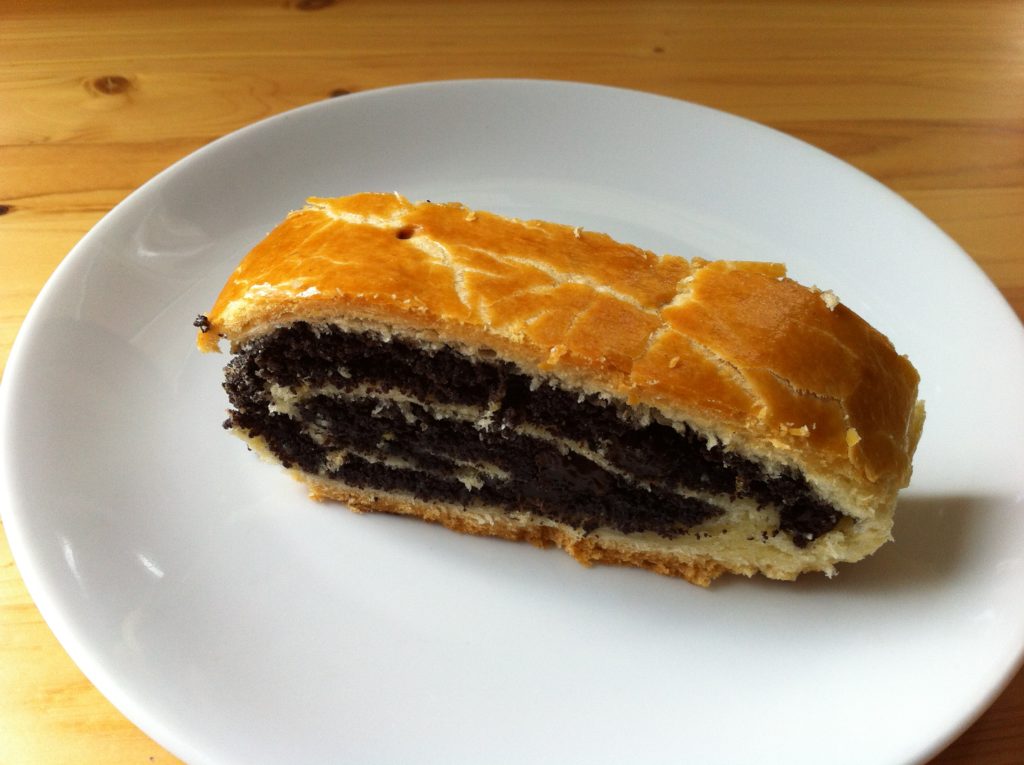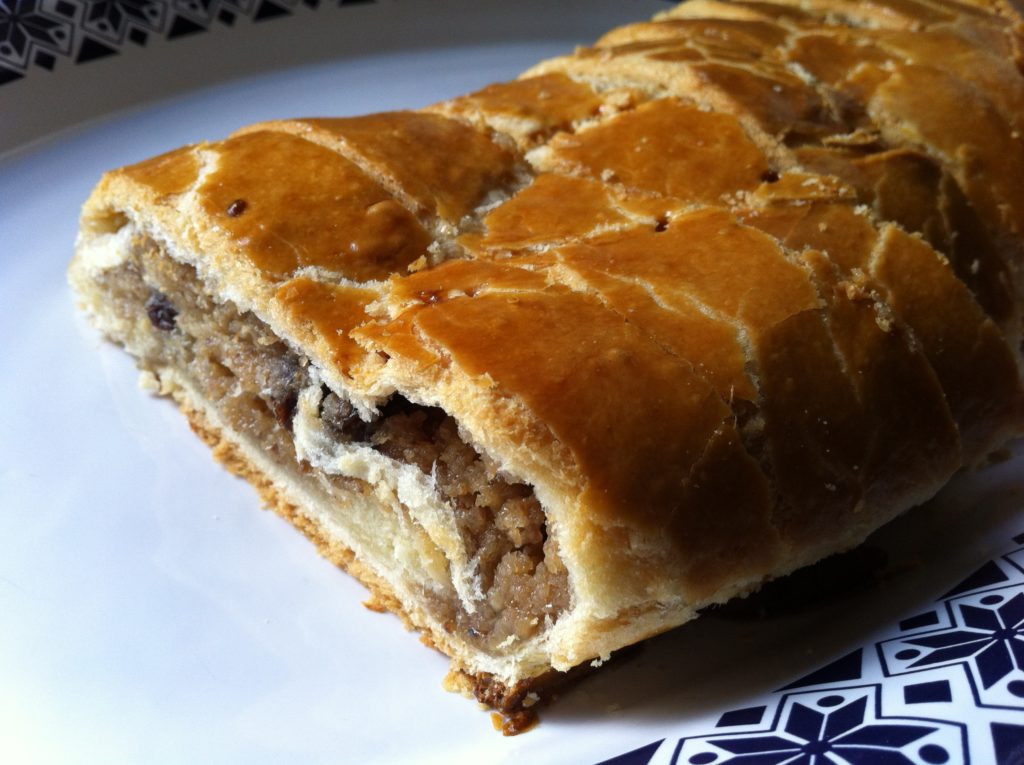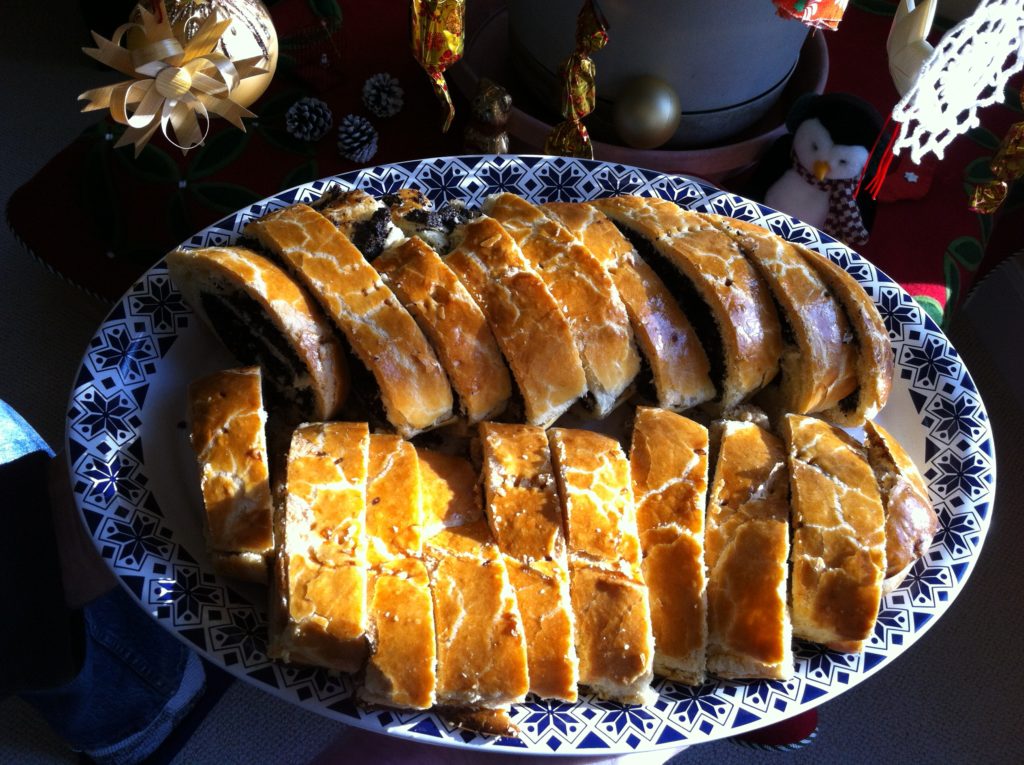I’ve had many successes and failures with bejgli. This traditional yeasted dough, filled with poppy seeds and ground walnuts, is very popular in many Central– and Eastern–European nations. The Hungarian Christmas is almost unimaginable without it.
I bake it every year, even though it’s quite time–consuming. I prepare the dough the night before baking, which helps with the time management and even improves the quality of the pastry.
The Hungarian word bejgli comes from the German Beugel, meaning horseshoe, which was the original shape of the pastry. The origins of the pastry dates back to 14th century Silesia (mainly part of Poland). It became popular in Hungary in the second half of the 19th century when Hungarians started celebrating Christmas according to German traditions. The first mention of bejgli in a Hungarian cookbook written in 1830 by István Czifray, named “posonyi finom mákos kaláts.” Its popularity is not fading – the historic Gerbeaud bakery in Budapest still has it on the menu. And why are poppy seeds and walnuts the filling? In folklore, poppy seeds symbolize richness and good health, walnuts protect against bad luck.
There is much anxiety around bejgli making. Everyone wants a perfect, marble-top looking pastry, which requires practice and some tricks. Rest the dough in a cold environment, figure out the equal dough-filling ratio, the thickness of the rolled-out dough, and the perfect structure of the filling – just to mention a few. The main accident surrounding bejgli is that the pastry could break, the filling might run out from it during baking. One of our friends said to me that the best bejgli is the one, which actually breaks during baking. If its soul is fine, everything beyond that is just hypocrisy, said one of my other friends.
So, give it a try, it’s really worth it. The taste matters the most, and that will be exceptional, no matter what. There are many different variations of the recipe. Mine makes 4 smaller or 2 large rolls. If it’s not eaten right away, it can be frozen successfully.
for the dough
all-purpose flour – 500 g
salt – a pinch
unsalted butter – 250 g
fresh (compressed) yeast – 25 g
powdered sugar – 50 g
sour cream – 150 ml
egg – 1
for brushing
egg – 1
for the poppy seed filling
ground poppy seeds – 200 g
powdered sugar – 200 g
zest and juice from 1 lemon
raisins – 50 g
rum – 30 ml
little milk – only if needed
for the walnut filling
ground walnuts – 200 g
powdered sugar – 200 g
milk – 50 ml
vanilla sugar – 20 g
raisins – 50 g
rum – 30 ml
fine bread crumbs – only if needed, about 1 tablespoon
To make the dough, sift the flour into the bowl of an electric mixer (Kitchen Aid), mix in the salt. Add the butter, crumble the yeast into it, then add the powdered sugar, sour cream, and egg. Knead with the hook attachment until the dough comes away from the side of the bowl. (Alternatively, all the mixing and kneading could be done by hand.) Knead the dough a few minutes by hand on a work surface, then divide it into 4 equal parts, form into balls. Wrap tightly in foil (or seal in a plastic bag), and rest in the refrigerator overnight.
The next day, make the fillings, assemble the rolls, and bake them. First, wash all the raisins in hot water, drain them, then soak them in all the rum in a covered bowl for 30 minutes, and then drain again.
For the poppy seed filling, mix together the finely ground poppy seeds, sugar, lemon zest and juice, and half of the raisins. Do this by hand to feel the crumbly texture of the filling. If it appears to be too dry, add a little milk, but don’t make it runny because it will leak out from the pastry during the baking. The filling is good when you can make balls from it.
For the walnut filling, mix together the ground walnut, sugar, vanilla sugar, the other half of the raisins, and a little milk by hand, paying attention to the texture. If it seems a little bit runny, add a small amount of fine bread crumbs.
On a floured work surface, roll out the dough, one-by-one, into a rectangle to about 3 mm thickness. Press down the edges a little bit. Spread half of the poppy seed filling evenly on the dough, leaving a half inch border around it. Fold over the short sides a little bit. Brush the edges with a beaten egg. Starting with the longer side, roll the dough up. Don’t roll very tight, but don’t keep it very loose either. Repeat with the other half of the poppy seed filling, then make the two walnut rolls in the same fashion.
Place the rolls on a parchment lined baking sheet, seam-side down, and leave a generous gap between them. Brush the pastry with a beaten egg and rest it until the egg dries. Then brush it again with the egg, rest for 30 minutes in a cool spot, then make a few holes on the top, removing the little pieces of dough. Alternatively, you can make smaller holes with a straw or pierce both the top and the sides with a toothpick. This will allow the steam to escape during baking, and will prevent the rolls from splitting. While the pastry is resting, preheat the oven to 350 °F. Bake for 30-40 minutes until golden. Cool on the baking sheet. To serve, cut into thick slices.
Sok sikert és sok kudarcot megértem már bejgli sütéseim során. Ez a hagyományos, mákkal és dióval töltött élesztős tészta számos közép– és kelet–európai országban nagyon népszerű. A magyar karácsony szinte elképzelhetetlen nélküle. Én minden évben sütök bejglit, bár ez eléggé időigényes. A tésztát már előző este összeállítom, ami nagy segítség, s ráadásul az éjszakai pihentetés a tészta minőségét is javítja.
A magyar bejgli szó a német Beugel–ből származik, patkót jelent, ami a bejgli régi alakjára utal. A tészta eredete a a 14. századra nyúlik vissza, Szilézia vidékéről származik (ez manapság főleg Lengyelország része). Magyarországon a bejgli a 19. század második felében vált népszerűvé, amikor a magyarok a német hagyományok szerint kezdték ünnepelni a karácsonyt. A bejgli receptjét „posonyi finom mákos kaláts” néven először Czifray István 1830–ban kiadott szakácskönyvében találjuk. Népszerűsége töretlen – a történelmi Gerbeaud cukrászdában Budapesten a mai napig a menün szerepel. S hogy miért mákos és diós a bejgli? A népi hagyomány szerint a mák gazdagságot és jó egészséget szimbolizál, a dió rontás ellen véd.
A bejgli sütés körül általában nagy a szorongás. Mindenki tökéletes, márványos tetejű bejglire vágyik, ami nagy gyakorlatot és egy csomó trükköt igényel. A tésztát hideg környezetben kell pihentetni, el kell találni a tészta vastagságának és a töltelék mennyiségének egyenlő arányát, valamint a töltelék megfelelő állagát, hogy csak néhány példát említsek. Aztán ott van a leggyakoribb baleset, amikor kireped a tészta és kifolyik a töltelék. Az egyik barátunk azt mondja, a bejgli úgy igazi, ha megreped. Egy másik barátnőm szerint, ha a bejglinek szép és jó a lelke, a többi már csak képmutatás.
Szóval bejglisütésre fel, próbáld ki, tényleg megéri. Az íze a legfontosabb, és az kivételes lesz, bármi is történik. A recept sokféle változata létezik. Az enyém négy kisebb vagy két nagyobb tekercset eredményez. Ha netán nem fogyna el rögtön, a fagyasztást is kitűnően tűri .
a tésztához
liszt – 500 g
só – egy csipet
vaj – 250 g
élesztő – 25 g
porcukor – 50 g
tejföl – 150 ml
tojás – 1
a kenéshez
tojás – 1
a máktöltelékhez
darált mák – 200 g
porcukor – 200 g
1 citrom reszelt héja és leve
mazsola – 50 g
rum – 30 ml
tej – egy kicsi, ha szükséges
a diótöltelékhez
darált dió – 200 g
porcukor – 200 g
tej – 50 ml
vaníliás cukor – 20 g
mazsola – 50 g
rum – 30 ml
finom zsemlemorzsa – 1 evőkanál, ha szükséges
A tésztához a lisztet és a sót elkeverjük, elmorzsoljuk benne a vajat, beleszórjuk az élesztőt, hozzáadjuk a cukrot, tejfölt és a tojást. Én mindezt a konyhai robotgépben csinálom, de a tészta kézzel is készíthető. A lényeg, hogy rugalmas, jó állagú tészta álljon össze. Ha ez megvan, kézzel még egy kicsit átgyúrjuk, majd négy egyforma cipót formálunk, fóliába csomagoljuk (vagy egy nejlonzacskóba tesszük, amit légmentesen lezárunk), és egy éjszakán át a hűtőszekrényben pihentetjük.
Másnap elkészítjük a töltelékeket, összeállítjuk és megsütjük a bejgliket. Először a kétféle tölteléknél feltüntetett összes mazsolát forró vízben megmossuk, lecsepegtetjük és meglocsoljuk 6 cl rummal. Lefedjük, 30 percig érleljük, aztán újra lecsepegtetjük.
A mákos töltelékhez a finomra darált mákhoz adjuk a cukrot, citromhéjat, citromlét és a mazsola felét. Egy tálban kézzel (hogy érezzük a töltelék morzsalékosságát) jól összedolgozzuk. Ha nagyon száraz, egy kevés tejet adunk hozzá. Fontos, hogy ne legyen híg, mert különben kifolyik a bejgliből a sütéskor. Akkor jó, ha gombócot tudunk belőle formálni.
A diós töltelékhez a dióban kézzel elkeverjük a porcukrot, vaníliás cukrot, a mazsola másik felét és egy kevés tejet. Ha híg a töltelék, egy kevés zsemlemorzsát adunk hozzá.
A tésztacipókat lisztezett munkalapon egyenként kb. 3 mm vastagságú téglalapokra nyújtjuk. A téglalapok széleit kicsit elvékonyítjuk és egyenletesre elsimítjuk rajtuk a mákos- ill. diós tölteléket (fele-fele arányban). Oldalain 2-3 centimétert szabadon hagyunk. A tésztát a két rövidebb oldalon visszahajtjuk a töltelékre, a széleket körben megkenjük tojással, végül a hosszabbik oldalán kezdve feltekerjük (se nem túl szorosra, se nem túl lazára).
Egy tepsit kibélelünk sütőpapírral, ráhelyezzük a tekercseket (kis rést hagyva közöttük). Tetejüket megkenjük a felvert tojással, s hagyjuk megszikkadni. Aztán újra megkenjük tojással, és hideg helyen további 30 percet pihentetjük. Majd néhány lyukat csinálunk a tetején, pl. szívószállal vagy habzsák csövével, s eltávolítjuk a pici tésztákat. Ha nem szeretnénk nagy lyukakat a bejglin, a tekercsek tetejét és oldalát fogpiszkálóval is megszurkálhatjuk. Ez a művelet nagyon fontos, mert a sütés során felgyülemlett gőzöknek el kell távozni a bejgliból, különben könnyen szétrepednek. A bejgliket 180 °C-os előmelegített sütőben 30-40 perc alatt aranybarnára sütjük. Tálaláskor ujjnyi vastag szeletekre vágjuk.
